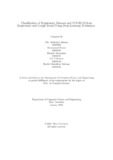| dc.contributor.advisor | Noor, Jannatun | |
| dc.contributor.author | Ahasan, Md. Mubtasim | |
| dc.contributor.author | Fahim, Mohammad | |
| dc.contributor.author | Mazumder, Himadri | |
| dc.contributor.author | Fatema, Nur E | |
| dc.contributor.author | Rahman, Sheikh Mustafizur | |
| dc.date.accessioned | 2022-06-01T05:02:39Z | |
| dc.date.available | 2022-06-01T05:02:39Z | |
| dc.date.copyright | 2022 | |
| dc.date.issued | 2022-01 | |
| dc.identifier.other | ID 18101195 | |
| dc.identifier.other | ID 18101487 | |
| dc.identifier.other | ID 18101041 | |
| dc.identifier.other | ID 18101340 | |
| dc.identifier.other | ID 18101610 | |
| dc.identifier.uri | http://hdl.handle.net/10361/16780 | |
| dc.description | This thesis is submitted in partial fulfillment of the requirements for the degree of Bachelor of Science in Computer Science and Engineering, 2022. | en_US |
| dc.description | Cataloged from PDF version of thesis. | |
| dc.description | Includes bibliographical references (pages 56-61). | |
| dc.description.abstract | Infectious and non-infectious respiratory diseases are among the major reasons for
deaths, financial and social crises around the world. However, medical personnel
still find it very difficult to detect the diseases using conventional methods to combat
this global crisis. We propose a respiratory disease identification method from
respiratory auscultation sounds and COVID-19 infected and healthy patients from
cough sound recordings. Our experiments demonstrate that artificial intelligence
can be utilized as an alternative method to detect respiratory illnesses. We extract
image representations of audio features such as Mel-frequency Cepstral Coefficients
(MFCCs) and Mel-Spectrogram from each audio recording and use convolutional
neural network models for our experiments. Also, we compare the two audio features
and ten different convolutional neural network architecture’s performance on
disease classification. We conduct experiments with various model training procedures’
such as transfer learning and 1cycle policy, and balanced mini-batch training.
In our experiment, we classified respiratory diseases with 94.57 percent accuracy
and 0.93 ROC-AUC scores and COVID-19 affected and healthy patients’ cough
recordings with 85.96 percent accuracy and 0.84 ROC-AUC scores. | en_US |
| dc.description.statementofresponsibility | Md. Mubtasim Ahasan | |
| dc.description.statementofresponsibility | Mohammad Fahim | |
| dc.description.statementofresponsibility | Himadri Mazumder | |
| dc.description.statementofresponsibility | Nur E Fatema | |
| dc.description.statementofresponsibility | Sheikh Mustafizur Rahman | |
| dc.format.extent | 61 pages | |
| dc.language.iso | en | en_US |
| dc.publisher | Brac University | en_US |
| dc.rights | Brac University theses are protected by copyright. They may be viewed from this source for any purpose, but reproduction or distribution in any format is prohibited without written permission. | |
| dc.subject | Deep learning | en_US |
| dc.subject | Respiratory diseases | en_US |
| dc.subject | Cough sound | en_US |
| dc.subject | Covid-19 | en_US |
| dc.subject | Mel-Spectrogram | en_US |
| dc.subject | MFCC | en_US |
| dc.subject | CNN | en_US |
| dc.subject.lcsh | Machine learning | |
| dc.subject.lcsh | Neural networks (Computer science) | |
| dc.subject.lcsh | Cognitive learning theory (Deep learning) | |
| dc.title | Classification of respiratory diseases and COVID-19 from respiratory and cough sound using deep learning techniques | en_US |
| dc.type | Thesis | en_US |
| dc.contributor.department | Department of Computer Science and Engineering, Brac University | |
| dc.description.degree | B. Computer Science | |

